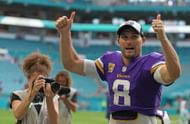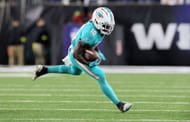Having already covered the Cincinnati Bengals' early-season struggles on offense and power rankings at the quarter-pole of the NFL season, among other topics, this is the right time to really dive into one of the more exciting games from this past weekend.
The Minnesota Vikings ground out a win over the Miami Dolphins to improve to 5-1 on the season. The Vikings have the second-best record in the NFC and already have one foot in the postseason.
Meanwhile, the Dolphins' slump continued as they registered their third straight defeat.
Here, we take a look at some of the factors that impacted the game:
Looking to predict NFL playoff Scenarios? Try our NFL Playoff Predictor for real-time simulations and stay ahead of the game!
Vikings Offense vs. Dolphins Defense

One of the biggest mysteries in the NFL right now – what is this Vikings offense? In Week One, they came out looking like the LA Rams, using 11 personnel on two thirds of snaps, while this past Sunday they were in 12 or 21 personnel on nearly 60% of their plays.
Don’t get me wrong, I’m not against either and really like what they can present from heavier sets, where they use seven-man protections and can attack with deep digs and double-post concepts off play action.
Unlike the Atlanta Falcons, who mix up groupings and make it tough for the defense to figure out how to counter them, Minnesota doesn't really have an actual identity. They only picked up 11 first downs, with just two of those coming on the ground, and they went two-of-12 on third downs.
Outside of the 53-yard breakaway touchdown run by Dalvin Cook, he went 12 for 24 the rest of the day. Kirk Cousins, meanwhile, was unwilling to hang in and pull the trigger when they had some deeper play actions drawn, along with frequently throwing the ball short of the sticks to his outlets/checkdowns on third downs.
What was most impressive was Justin Jefferson's ability in one-on-one situations. If he's given some schematic advantages against match-zone and shells, the Vikings' entire offense is more effective.
In Week One versus the Packers, they had defensive backs rolling their eyes and pointing fingers, but they kind of got away from it after that. In Miami, they gave Jefferson a couple of layups.
In the first half, they used something they saw on tape against the Dolphins defense. They moved into a loose bunch set and faced one-man, with Xavien Howard having outside leverage on #18, who made it look as if he was running a shallow cross, forcing the corner to work over the top of the middle receiver. He then whipped it back outside and nobody was within 15 yards of him.
Later at the turn of the third to the fourth quarter, they ran a pick play with Adam Thielen and Jefferson as the three out of a trips set, working a cross release. Jefferson had a ton of space to the sideline for a wheel route.
Both of them directly set up touchdowns.
The Dolphins held Minnesota’s ground game in check other than the long Cook TD, where they had a couple of would-be tacklers slip off the running back. Minnesota allowing them to stay in base personnel thanks to the multi-tight end and running back sets certainly helped, with the beef they can put out with the interior three.
In obvious passing situations, they stuck with their formula of overloading the front and creating free rushers. Miami was able to get home three times, along with pressuring Cousins on 24.2% of dropbacks. But the visitors had some answers, in terms of working in those seven- and semi-eight man protections to block up the rush off play action.
Christian Wilkins really dominated the interior of Minnesota’s O-line. He won his gap, mirroring the blocking scheme of that triangle inside, to lead him to the ball on any type of pulling setup and crashing into bodies to create push up the middle of the pocket.
Rookie right guard Ed Ingram had some really rough moments in protection, allowing guys to run through and get quick pressure on Cousins.
For less-experienced quarterbacks without a clear plan on how to deal with those pressure looks, Miami'll be able to create havoc, but they’re at danger of offenses having solutions.
Dolphins Offense vs. Vikings Defense

For people saying that stats don’t lie, you need to look at the drive logs in this case. Miami nearly doubled the Vikings in total offensive yardage (458 vs. 234), but 224 of those were in semi-garbage team, when they were down by multiple scores for 13 of 15 minutes in the fourth quarter.
In the first half, they had four possessions of at least seven plays, but only came away with three total points. Pass-protection was and will remain a major concern for them. Every starter but Connor Williams surrendered multiple pressures, including Greg Little, who was stepping in for the injured Terron Armstead at left tackle. He was responsible for 10 pressures and earned a 0.0 PFF grade.
Although, in fairness to him, one of the three sacks he was charged with by Za’Darius Smith wasn’t really on him, as they asked the tight end to come underneath the formation off play-action and he tried to take a flat angle down the line, running straight into the left tackle. Moreover, Teddy Bridgewater spun his way into the arms of Smith later on and tried the same, where he was ultimately called for intentional grounding.
What was impressive about Mike McDaniel’s run game was having them start in an ace set, with a tight-end and fullback Alec Ingold offset on either end of the line. They then motioned the latter across at the snap, to get that extra body to lead the way on toss plays. All the Vikings did to counter was have the safety walk down a little bit, giving them that plus one on the front-side.
Miami also utilized fly sweep fakes to freeze second-level defenders a little bit. However, Raheem Mostert stopped his feet way too often and allowed the defense to flow and corral him, rather than just planting the outside foot and getting vertical.
As for Mike Gesicki, coming into Sunday, he had caught just nine of 12 targets for 101 yards. However, he turned up big-time against the Vikings, hauling in six of seven for 69 yards and two touchdowns.
As they go to more spread looks to give their playmakers space and a clear picture for the quarterback, rather than using a more condensed formation, Gesicki should become a bigger part of the passing attack.
There are still some questions about this Vikings defense, most notably how predictive their coverage checks are depending on formation, down and distance. It felt like Miami’s quarterbacks had way too many completions set up pre-snap, because they knew where those passing windows would develop.
The Vikings didn’t really adjust when the Dolphins created that plus one in their run-game design. However, this unit does have a knack for taking the ball away; they're one of four teams with at least one takeaway in all six of their games.
In terms of their gameplan for this matchup, when Miami ran play-action from the shotgun and left the backside defensive end unblocked, that guy was assigned to just aim for the quarterback and they landed multiple hits on Teddy Bridgewater that way.
Their pass-rush has been much more potent this season, with Za’Darius Smith being a real weapon.
Patrick Peterson probably had his best game as a Viking, making three big plays on the ball. He drove down on a stick route from Jaylen Waddle and then raked the ball out of his hands on the very next play, when he was working across the field. He also had a late interception when he fell of his deep responsibility, recognizing a flood concept his way and stepping in front of the pass to the intermediate level with the sail route.
He wasn’t the only veteran DB on Minnesota’s side with a flashback performance, as Harrison Smith broke up a couple of passes and directly set up 10 points. He had that jungle interception just before halftime and then swiped at the ball late in the fourth quarter, with Waddle walking trying to cross him on an explosive play.
Despite 5-1 start, Vikings still have problems to address
The Vikings are 5-1 with a two-game lead in the NFC North and have enough talent on the roster to trade blows with anybody in that conference outside of Philadelphia probably.
But they'd be wise to lean more into a certain style of play on offense, while the defense opens up the playbook more on the back end.
Za’Darius Smith has to get some credit, as he has now recorded at least half a sack in all but one of their six games this season and been instrumental in changing around what that pass-rush looks like.
The two plays that caught the eye – that Harrison Smith interception was one of craziest interceptions ever seen, as it was simultaneous possession between Eric Kendricks and Smith. And something that most people probably didn’t see was Miami’s fake punt, when they were trying to kick-start the offense while down 10-3 following a three-and-out to start the second half.
The play call wasn't bad, because it was fourth-and-one and I believe if the upback Clayton Fejedelem cut it back inside of trying to bounce, he would've picked it up. Instead, we need to credit rookie linebacker Brian Asamoah for occupying two blockers, allowing Josh Metellus behind him to scrape out to the sideline and knock the ball-carrier out just before the sticks.
Other than a couple of deep comebacks on the outside to Tyreek Hill and Jaylen Waddle breaking deep over the middle of the field once, basically all the passes Miami caught on Sunday were short of the marker and largely behind the line of scrimmage.
That feels like a kind of disservice to the receivers they have as good as they may be at accumulating yards after the catch. Miami needs to make itself hard to defend by stretching defenses horizontally and vertically.
Playmakers and creative play designs can certainly create some big plays for an offense, but if they don’t consistently get Tua Tagovailoa to deliver in those high-leverage moments – which he has done mostly to his credit – this could end up being San Francisco without the O-line, outside of Terron Armstead.
On the other side, defensive coordinator Josh Boyer may need to adjust his approach to some degree and be able to flip the switch in-game, similar to what we saw with the million variations of getting to cover-two against Buffalo back in week three.
One issue for the team as a whole – they accumulated 10 penalties for just under 100 yards, which combined with the zero-to-three turnover disadvantage is not a recipe for success.
Miami Dolphins Nation! Check out the latest Miami Dolphins Schedule and dive into the Dolphins Depth Chart for NFL Season 2024-25.
